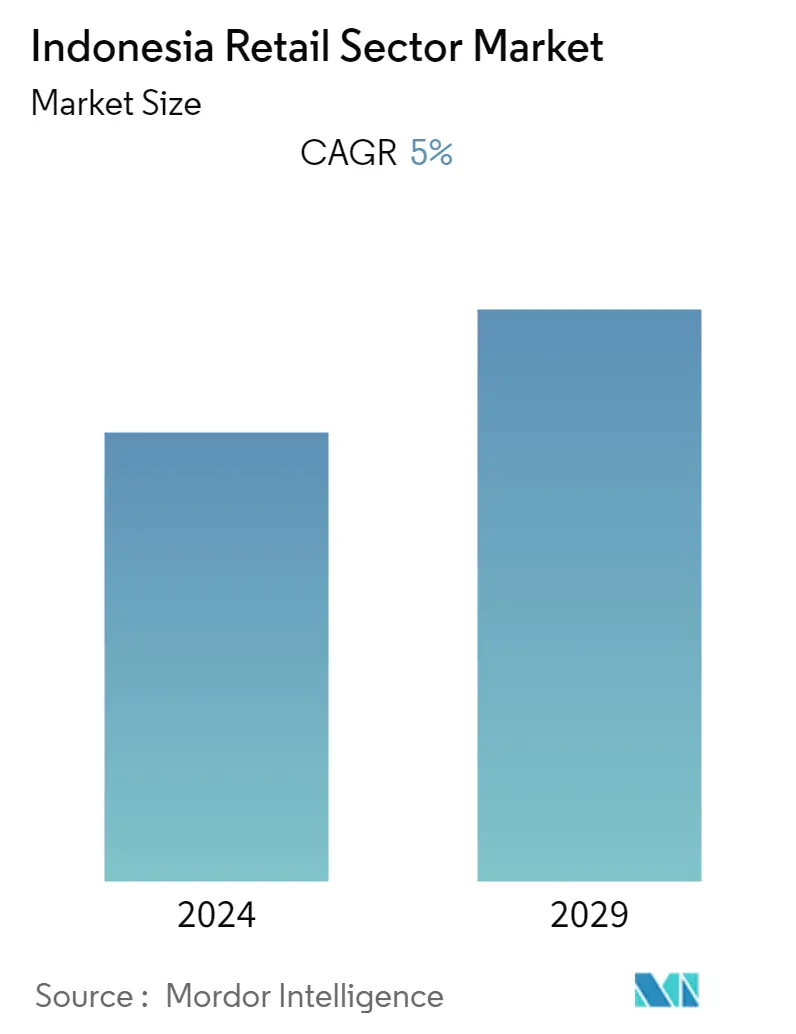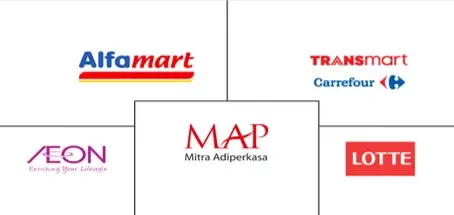Market Size of Indonesia Retail Sector Industry

| Study Period | 2019 - 2029 |
| Base Year For Estimation | 2023 |
| Forecast Data Period | 2024 - 2029 |
| Historical Data Period | 2019 - 2022 |
| CAGR | 5.00 % |
Major Players
*Disclaimer: Major Players sorted in no particular order |
Retail in Indonesia Market Analysis
The retail sector in Indonesia remains one of the most promising markets among Asian countries, on the back of its large population and the growing middle class with higher household purchasing power and increasingly modern spending habits. However, the sudden COVID-19 pandemic has pushed the market into lockdowns, resulting in a drop in the revenues of the physical distribution channels. The small and unorganized players incurred several losses, of which some result in a temporary halt of the business activities. Though the consumption was largely affected by higher prices for food, electricity, etc., during the initial year of the study period, i.e., during 2018, the retail sector got back to track with the support of lower credit cost, increasing employment, and an expansion of social welfare.
In Indonesia, household consumption has slowed down in the past two years, which is a great concern, as household consumption has been the biggest driving factor for the economy and is of greater importance than investment, exports, and government spending. Private consumption in the form of household spending has always accounted for more than 50% of the nation's GDP yet. There has been a slowdown in consumption growth. The retailer's profit margins were unstable during the study period and were largely affected by the sudden COIVD-19 pandemic. The retail sector is expected to witness a slow recovery rate in the country owing to the people's purchasing power which remained sluggish due to the pandemic.
Retail in Indonesia Industry Segmentation
The report on the Indonesian retail sector provides a comprehensive evaluation of the market, with an analysis of the segments in the market. Moreover, the report also provides the competitive profile of the key manufacturers, along with regional analysis. The Indonesia retail industry is segmented by products (food and beverages, personal and household care, apparel, footwear, and accessories, furniture, toys, and hobby, electronic and household appliances, and other products) and distribution channel (supermarkets/hypermarkets, convenience stores, and department stores, specialty stores, online, and other distribution channels). The report offers market size and forecasts for the retail sector in Indonesia in value (USD million) for all the above segments.
| By Product | |
| Food and Beverages | |
| Personal and Household Care | |
| Apparel, Footwear, and Accessories | |
| Furniture, Toys, and Hobby | |
| Electronic and Household Appliances | |
| Other Products |
| By Distribution Channel | |
| Supermarkets/Hypermarkets, Convenience Stores, and Department Stores | |
| Specialty Stores | |
| Online | |
| Other Distribution Channels |
Indonesia Retail Sector Market Size Summary
The retail sector in Indonesia is a significant player in the Asian market, driven by a large population and an expanding middle class with increased purchasing power and modern spending habits. Despite the challenges posed by the COVID-19 pandemic, which led to temporary business disruptions and a decline in revenues for physical distribution channels, the sector has shown resilience. The initial impact of the pandemic was felt through higher prices for essential goods, but supportive measures such as lower credit costs, increased employment, and social welfare expansion helped the sector recover. However, household consumption, a critical driver of the economy, has experienced a slowdown, affecting retailer profit margins and overall market stability. The retail landscape is evolving, with a notable shift towards digital technology and online commerce, although physical retailing still holds a dominant position.
The food and beverage sector is a crucial component of Indonesia's economy, balancing between being a major producer of commodities like palm oil, fish, cocoa, and coffee, and relying on imports for products not sufficiently produced locally. Despite the pandemic's initial impact, the F&B sector demonstrated resilience with positive growth rates. The organized retail market is expanding, with major players increasing their presence and replacing unorganized outlets with hypermarkets and supermarkets. This trend is expected to continue, contributing to market growth. The report highlights the presence of international players in the Indonesian retail market, with companies like PT Matahari Putra Prima Tbk and Alfamart leading the charge in expanding their store networks.
Indonesia Retail Sector Market Size - Table of Contents
-
1. MARKET INSIGHTS AND DYNAMICS
-
1.1 Market Overview
-
1.2 Market Drivers
-
1.3 Market Restraints/Challenges
-
1.4 Value Chain/Supply Chain Analysis
-
1.5 Porter's Five Forces Analysis
-
1.6 Consumer Behavior Analysis
-
1.7 Insights into Technological Innovations in the Retail Industry
-
1.8 Impact of COVID-19 on the Market
-
-
2. MARKET SEGMENTATION
-
2.1 By Product
-
2.1.1 Food and Beverages
-
2.1.2 Personal and Household Care
-
2.1.3 Apparel, Footwear, and Accessories
-
2.1.4 Furniture, Toys, and Hobby
-
2.1.5 Electronic and Household Appliances
-
2.1.6 Other Products
-
-
2.2 By Distribution Channel
-
2.2.1 Supermarkets/Hypermarkets, Convenience Stores, and Department Stores
-
2.2.2 Specialty Stores
-
2.2.3 Online
-
2.2.4 Other Distribution Channels
-
-
Indonesia Retail Sector Market Size FAQs
What is the current Indonesia Retail Sector Market size?
The Indonesia Retail Sector Market is projected to register a CAGR of 5% during the forecast period (2024-2029)
Who are the key players in Indonesia Retail Sector Market?
PT Matahari Putra Prima Tbk, Ramayana Lestari Sentosa, Mitra Adiperkasa, Alfartmart and PT Trans Retail Indonesia are the major companies operating in the Indonesia Retail Sector Market.

